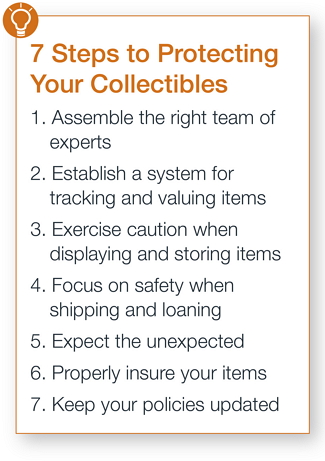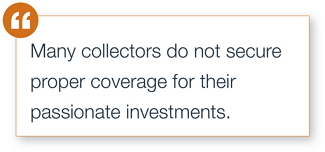Understand the risks to your valued collections.
Curators of fine art, wine and antiques are passionate about their
collectibles. Whether family heirlooms or procured rarities, collectibles can hold a tremendous amount of value, much the same as traditional stocks and bonds do. They may even transcend monetary value to their owner.
Yet, despite the sentiments that can accompany this kind of investment, collectors often fail to manage the risks involved with their collections – such as natural and criminal disasters - as they might do with more traditional financial investments. Understanding these
risks and how to mitigate them can prevent a world of heartache.
Here are seven steps collectors can take to protect their passionate investments:
- Assemble the
right team of experts.
 Understanding asset values and potential loss exposures is the first step. Get advice on how to best safeguard your collection from a team of experts: your insurance broker, the insurance company your broker recommends (typically a carrier that specializes in insuring your
type of collection) and an appraiser. An art conservation laboratory may also be needed, depending on your collection.
Understanding asset values and potential loss exposures is the first step. Get advice on how to best safeguard your collection from a team of experts: your insurance broker, the insurance company your broker recommends (typically a carrier that specializes in insuring your
type of collection) and an appraiser. An art conservation laboratory may also be needed, depending on your collection.
- Establish a
system for tracking and valuing items. As your collection grows, it’s important to have a system in place for tracking and valuation of items. Consider purchasing collection management software to track details such as the name of the object, size, condition, date of purchase and appraisal record.
- Exercise caution
when displaying and storing items. Avoid hanging paintings close to the floor where they are vulnerable to flood waters and damage from children and pets. Never display art above an active fireplace. Don’t place valuable rugs, paintings or antiques in areas with the potential for leakage, flooding or
excessive sunlight. If wine is your passion, store it in a temperature-controlled wine cellar where it can’t be damaged by
flood water.
- Focus on safety
when shipping and loaning. Use professional and reputable art shippers. If you're shipping by air, look for a certified cargo screening program that allows certified art shippers to inspect and seal packages and reduces the risk of airport security damaging your items. If you loan valuable items to a museum,
have your insurance broker examine the museum’s insurance policy to make sure your collection is appropriately covered.
- Expect the
unexpected. Make sure your homes have functional fire and smoke detection systems and consider installing a waterless fire protection system. Consider investing in perimeter and external security systems. If you need to move pieces from your home on short notice (e.g., during
hurricane season), create a relationship with an art transportation company and prioritize pieces for evacuation.
- Properly insure
your items. Many collectors do not secure proper coverage for their passionate investments.
 Too often they over-insure against minor risks and under-insure against major ones. Begin by working with a broker who understands how to best insure valued collections and can advise you on the following insurance that is often overlooked:
Too often they over-insure against minor risks and under-insure against major ones. Begin by working with a broker who understands how to best insure valued collections and can advise you on the following insurance that is often overlooked:
- Valued
Items Rider—Standard homeowners’ policies have minimal coverage for items like
jewelry, furs and wine, but a Valued Items rider covers items worldwide, including during transit and shipping. In case of a loss, the best policies will pay market value up to 50% higher than the scheduled amount of coverage.
- Floods and
Earthquakes—A basic plan usually excludes water backups, so make sure you have an All Risk policy that includes unlimited backup of sewers, drains and sump pumps.
- Mould—If there’s flooding in your home, mould won’t be far behind. All standard homeowners' policies have limitations for mould, but extra coverage can be purchased for an additional premium.
- Liability—Liability insurance protects your assets if you become the target of a lawsuit. People who attempt to self-insure for liability can wind up losing everything. Individuals who want to go beyond the payouts on their home
and auto policies should buy an umbrella policy with a personal excess liability limit equal to their net worth.
- Keep your
policies updated.If you add items to your collection, make sure to update your coverage. The best insurance companies automatically provide coverage for new items, but they usually require notice between 30 and 90 days after purchase, depending on the item.
Unique and valuable collections require a special kind of safety net. The passionate investor cannot overestimate the importance of having the right partners to provide sound advice.